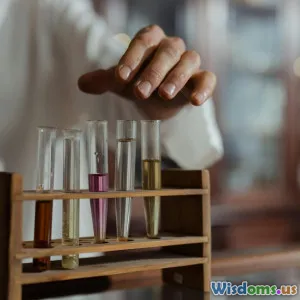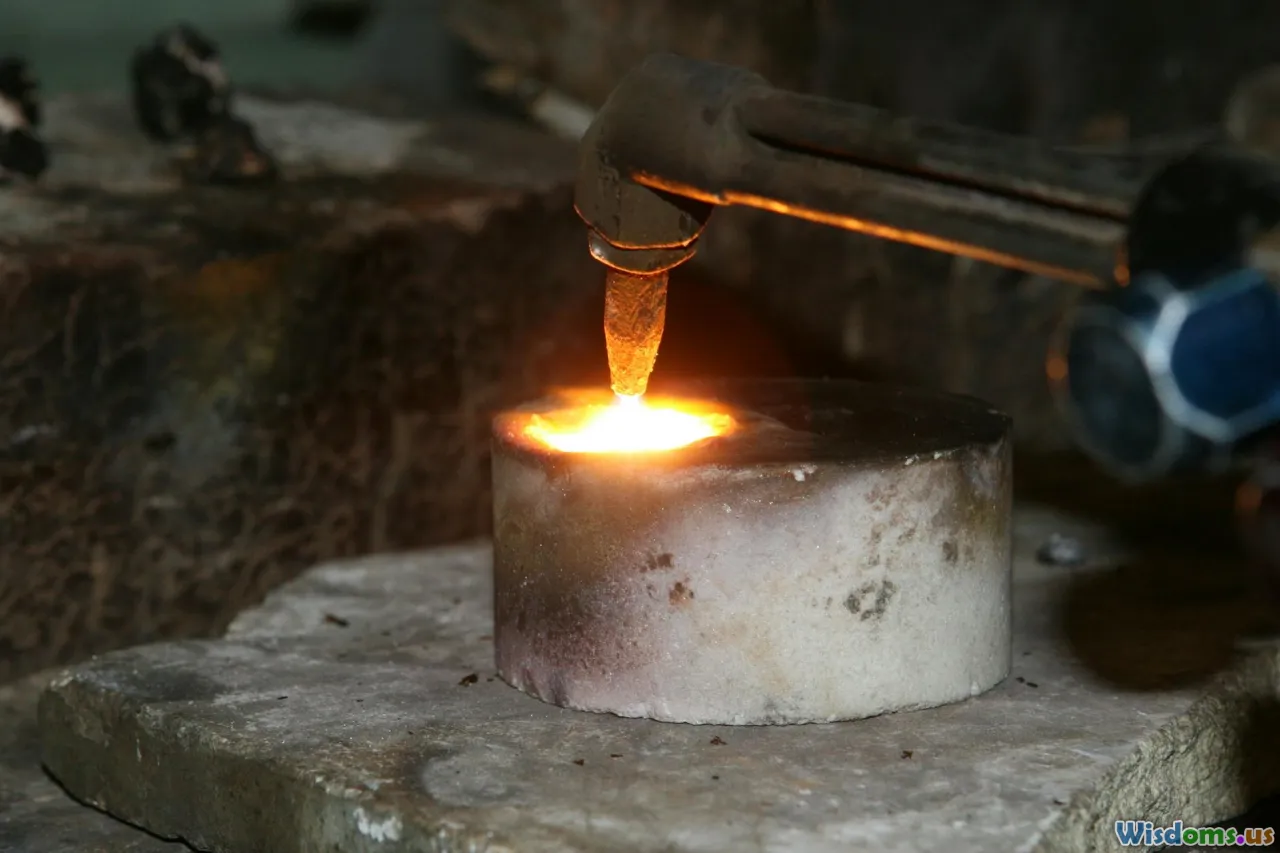
The Story Behind Iconic Chemical Reactions
17 min read Discover the fascinating stories and science behind some of history’s most iconic chemical reactions. (0 Reviews)
The Story Behind Iconic Chemical Reactions
Throughout history, chemistry has mesmerized scientists and laypeople alike—capable of fiery transformations, vibrant colors, and even explosions that change the course of industry and science. Hidden behind these dramatic displays are chemical reactions whose stories encapsulate human curiosity, ingenuity, and perseverance. Let's embark on a journey through time and molecules to unravel the tales behind some of the world's most iconic chemical reactions.
Kidnapping Chemistry: The Birth of Modern Explosives

Long before fireworks adorned our night skies, explosions mostly meant disaster. That changed in the 19th century, led by one determined chemist: Alfred Nobel. While experimenting with highly volatile nitroglycerin, Nobel sought a safer way to harness its power. In a tragic demonstration of this peril, an explosion claimed his younger brother's life in the family factory, prompting Nobel to double down on safety.
He discovered that mixing nitroglycerin with a fine silica, kieselguhr, stabilized the explosive enough for practical usage. Thus, in 1867, Nobel patented dynamite, which instantly revolutionized construction, mining, and warfare. The controlled, powerful reaction of nitroglycerin decomposition—accelerated by a shock or flame—frees immense gaseous energy within microseconds:
4 C₃H₅N₃O₉ → 6 N₂ + 10 H₂O + 12 CO₂ + O₂
From the Panama Canal to the Alps-spanning Gotthard Tunnel, dynamite blasted through barriers both literal and technological. Ironically, the fortune Nobel amassed from this invention later funded the Nobel Prizes—an enduring testament to chemistry's ability to both build and uplift humanity.
Flames of Innovation: The Thermite Reaction

Sometimes, beauty lies in simplicity. The thermite reaction—a high-temperature exothermic reaction between a metal oxide and aluminum—stands as a headline act in chemical theater. Discovered in the 1890s by German chemist Hans Goldschmidt, this powerful process welds railroad tracks, arms incendiary devices, and even inspires classroom demonstrations.
The most popular version combines iron(III) oxide (rust) and aluminum powder:
Fe₂O₃ + 2 Al → 2 Fe + Al₂O₃ (ΔH ≈ –850 kJ/mol)
Upon ignition (often with magnesium ribbon), the thermite mixture produces molten iron—reaching up to 2500°C—hot enough to flow like lava and fuse metaphorical lifelines across continents in seconds.
In industry, thermite’s real-world prowess arrived in the early 20th century through Goldschmidt's Thermit process for welding railway track and repairing machine parts in situ. Even today, its ability to make new metal joints without external heat sources is prized. On the lighter side, spectacular thermite demonstrations continue to light up chemistry classrooms across the world—a dazzling reminder of chemical power at our fingertips.
Color Alchemy: Magic of the Belousov-Zhabotinsky Reaction

While chemistry is often seen as exact and predictable, oscillating reactions like the Belousov-Zhabotinsky (B-Z) reaction break the mold—literally. Discovered by Soviet scientist Boris Belousov in the 1950s, this mysterious series of reactions flips between seemingly impossible states, producing mesmerizing periodic color changes. Initially dismissed by peers as mistaken or impossible, Belousov struggled for years before Simon Zhabotinsky refined and published the phenomenon.
A standard B-Z reaction involves malonic acid, potassium bromate, and cerium or ferroin as a catalyst, continuously oscillating between colored states. These spontaneous cycles mimic patterns seen in nature, such as heartbeats and circadian rhythms—a finding that has implications from biochemistry to chaos theory.
- Why does it matter? The B-Z reaction proved non-linear chemistry is possible, laying the foundation for research in complex systems—even suggesting how chemicals could self-organize in the primordial soup to create life.
- A classroom marvel: Teachers demonstrate the B-Z reaction for students, waving glowing blue and red solutions to show that chemistry can literally flip its own script.
Room for Night and Light: The Chemistry of the Haber-Bosch Process

Making fertilizer seems unremarkable…until you consider its global impact. The Haber-Bosch process, pioneered by Fritz Haber and Carl Bosch, made it possible to "fix" atmospheric nitrogen, a nonreactive pain point in nature, into ammonia (NH₃), a building block for food and explosives.
The reaction:
N₂ (g) + 3 H₂ (g) ⇌ 2 NH₃ (g) ΔH = -92.4 kJ/mol
occurs only under intense pressure (150–250 atmospheres), elevated temperature (400–500°C), and with iron-based catalysts. Developed on the eve of World War I, it had instant military implications for German explosives, but more lastingly, for agriculture: half the world's population today depends on its products for sustenance.
- Environmental cost: The process consumes about 1–2% of the world’s energy today, illustrating how a single equation can feed billions, reshape geopolitics, and demand innovation for cleaner alternatives.
- Actionable tip: Scientists are exploring biological and electrochemical nitrogen fixation, inspired by microbes and renewable energy, to reduce this process's environmental impact.
Bright and Brazen: The Iodine Clock Reaction

If you’ve ever seen a liquid snap from clear to midnight blue—like a magician’s trick—that’s the iodine clock reaction at work. It’s one of chemistry’s most dramatic visual demonstrations, enthralling generations of students and scientists.
There are several versions, but all share a suspenseful build-up: reactants mix and seemingly do nothing, until a sudden color change erupts after a precisely timed delay. Here’s why: two separate reactions are occurring at different rates, one masked until it’s suddenly revealed. A classic version involves hydrogen peroxide and potassium iodide. The process:
- Hydrogen peroxide slowly oxidizes iodide ions to free iodine.
- Sodium thiosulfate instantly reduces iodine back—until it’s all used up.
- When thiosulfate is exhausted, excess iodine reacts with starch, flashing an inky blue and stopping the "clock."
This elegantly demonstrates reaction kinetics—how concentration, temperature, and catalysts influence rates. Today, it’s a perennial favorite at science fairs, echoing the thrill of discovering hidden chemical timepieces.
Lighting Lifeways: Photosynthesis and the Calvin Cycle

More than an academic marvel, photosynthesis is Earth's life engine. It captures solar energy, feeding almost every organism by converting sunlight, carbon dioxide, and water into sugars and oxygen—nature’s original chemical alchemy.
The overall simplified reaction:
6 CO₂ + 6 H₂O + light → C₆H₁₂O₆ + 6 O₂
But the story doesn’t end with sunbeams hitting green leaves. British chemist Melvin Calvin tracked carbon's movement through a series of enzymatic steps, now known as the Calvin cycle, using radioactive isotopes at UC Berkeley in the 1940s–50s. His work elucidated how raw materials are built into the carbon backbone of life—one molecule at a time.
Insights and impacts:
- Food security: Engineering crops via insights from photosynthesis can increase yields and carbon sequestration, a central mission for 21st-century agriculture.
- Artificial photosynthesis: Scientists now emulate these pathways to develop renewable solar fuels, drawing directly on nature’s lesson.
Colorful Cures and Everyday Explosions: Classic Redox Reactions

Many of life’s most vital—and dramatic—reactions are redox (reduction-oxidation) processes: from rusting bridges to respiring cells, burning fuel, or even healing scrapes with hydrogen peroxide's fizz. Let’s spotlight a few:
Combustion: Powering the World
Burning gasoline, wood, or candles? All rely on oxygen hungrily grabbing electrons from carbon-rich fuels and releasing heat, light, and CO₂. The typical combustion equation for methane:
CH₄ + 2 O₂ → CO₂ + 2 H₂O
Everyday Chemistry: Vitamin C and Permanganate
Classroom experiments often revive oxidants like potassium permanganate (bright purple) with reducing agents such as vitamin C (ascorbic acid). As vitamin C donates electrons, the color fades—a visible testament to invisible electron dances essential to both metabolism and industry.
- Tip for learners: Monitoring color changes can help students visualize electron transfer and redox equivalency, a core skill for budding chemists.
From Air to Water: The Ostwald Process and Nitric Acid

Where the Haber-Bosch process turns nitrogen to ammonia, the Ostwald process goes further—converting ammonia to nitric acid (HNO₃), a cornerstone chemical for fertilizers, explosives, and the dye industry. Invented by Wilhelm Ostwald in 1902 and rapidly industrialized, it demonstrates how one reaction can link global supply chains.
Steps include:
- Ammonia oxidation:
4 NH₃ + 5 O₂ → 4 NO + 6 H₂O - NO oxidation:
2 NO + O₂ → 2 NO₂ - Absorption:
3 NO₂ + H₂O → 2 HNO₃ + NO
Much like the Haber-Bosch process, the Ostwald process is an industrial linchpin, enabling high-yield agriculture and advancing modern medicine and manufacturing but also raising environmental challenges—notably NOₓ emissions—prompting ongoing innovation.
Going for Gold: The Cyanide Process and Mining Chemistry

Great wealth can hinge on chemistry as surely as coins are stamped. The cyanide process (also called cyanidation), revolutionized gold extraction in the late 19th century. Rather than brute-force crushing, ores were now treated with an alkaline cyanide solution, selectively dissolving gold to be later recovered via precipitation or adsorption.
4 Au + 8 NaCN + O₂ + 2 H₂O → 4 Na[Au(CN)₂] + 4 NaOH
While it vastly increased yields—and gold production globally—it brought severe environmental and health risks. High-profile spills, like the Baia Mare cyanide spill in Romania (2000), showed the devastating impact on water and wildlife. Today, this legacy drives chemists to seek green gold extraction alternatives, such as thiosulfate leaching.
Actionable advice: Investors and companies now value closed-loop containment, cyanide monitoring, and biological alternatives—turning responsible chemical processes into both an ethical and economic imperative.
The Blue Revolution: Synthetic Dyes and the Mauveine Explosion

At the confluence of fashion and chemistry lies the birth of synthetic dyes—a tale started by a failed attempt to synthesize quinine. In 1856, 18-year-old William Henry Perkin tried to create the antimalarial but ended up with a striking purple color, soon named mauveine. Instead of a cure, Perkin had synthesized the world’s first synthetic dye, unleashing a pigment revolution.
Textiles went bright at a fraction of prior costs, and the era’s purple craze swept across Victorian society—worn by royalty and commoners alike. This single serendipitous reaction seeded not just a chemical industry, but pharmaceuticals and plastics as well—since dye research opened doors to new organic synthesis routes.
Takeaway: Today’s vibrant clothing, affordable medicines, and colorful plastics all echo that first flask of accidental mauve.
Echoes of Glass: The Chemistry of Silicates and Everyday Marvels

Invisible chemistry builds the foundations for technology—quite literally, in the case of glass. Silicate chemistry dates back millennia, but modern glassmaking took center stage in the 19th century with clearer, more robust, and heat-resistant borosilicate glass.
What’s behind glass? At its core is the reaction:
Na₂CO₃ + CaCO₃ + 6 SiO₂ → 2 Na₂O·CaO·6SiO₂ + 3 CO₂
The crafting of test tubes, optical fibers, skyscraper claddings, and touchscreens all relies on the transformation of raw sands and fluxes into transparent solids. The flavors of glass—impossible without subtle tweaks in the chemistry—demonstrate how solutions, not just compounds, build civilization.
From Nobel's dynamite to the B-Z reaction's mesmerizing rhythms, every iconic chemical reaction reflects our drive to discover, build, and sometimes even accidentally stumble into innovation. Chemistry's greatest stories are not only written in textbooks but are lived out on planetary and personal scales—shaping the world, one reaction at a time.
Rate the Post
User Reviews
Other posts in Chemistry & Chemical Engineering
Popular Posts

















